Unit 2 Look into the Future Workbook 课件(共20张PPT)-2025-2026学年人教版(2019)选择性必修第一册
文档属性
| 名称 | Unit 2 Look into the Future Workbook 课件(共20张PPT)-2025-2026学年人教版(2019)选择性必修第一册 |
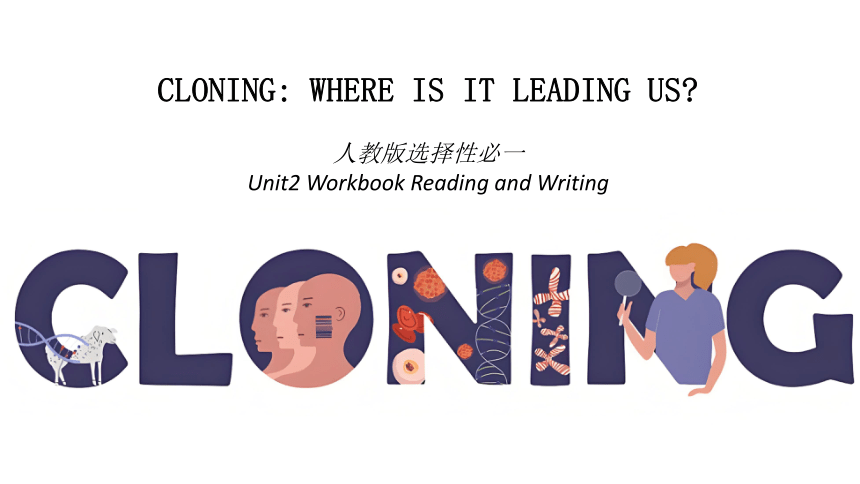
|
|
| 格式 | pptx | ||
| 文件大小 | 3.6MB | ||
| 资源类型 | 教案 | ||
| 版本资源 | 人教版(2019) | ||
| 科目 | 英语 | ||
| 更新时间 | 2025-07-17 10:05:21 | ||
图片预览

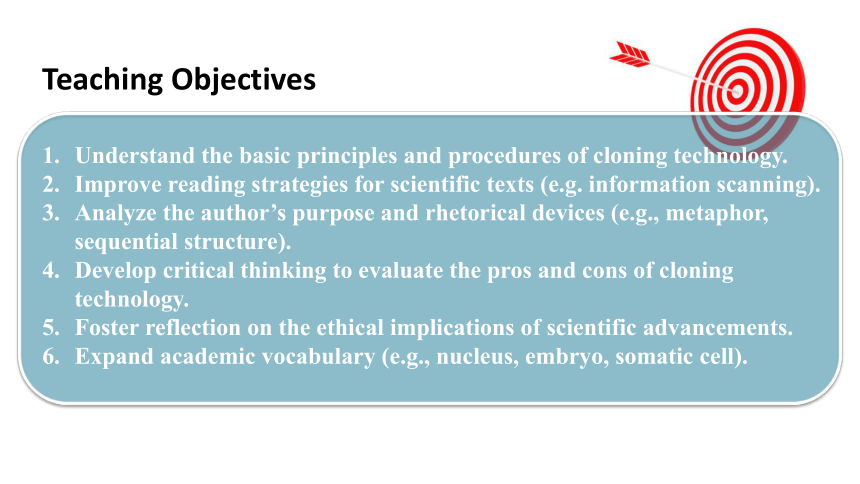
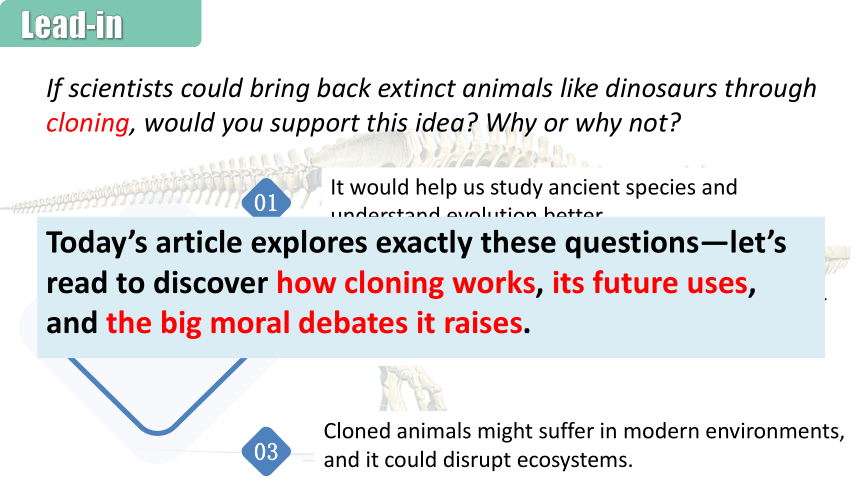
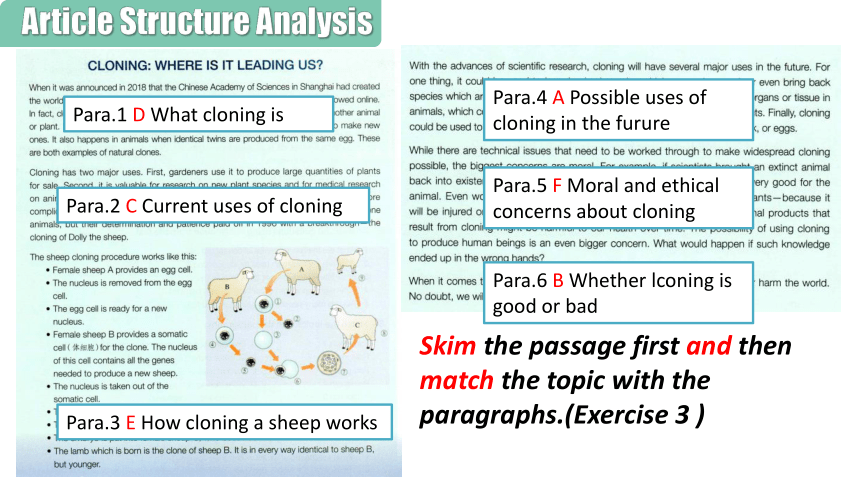
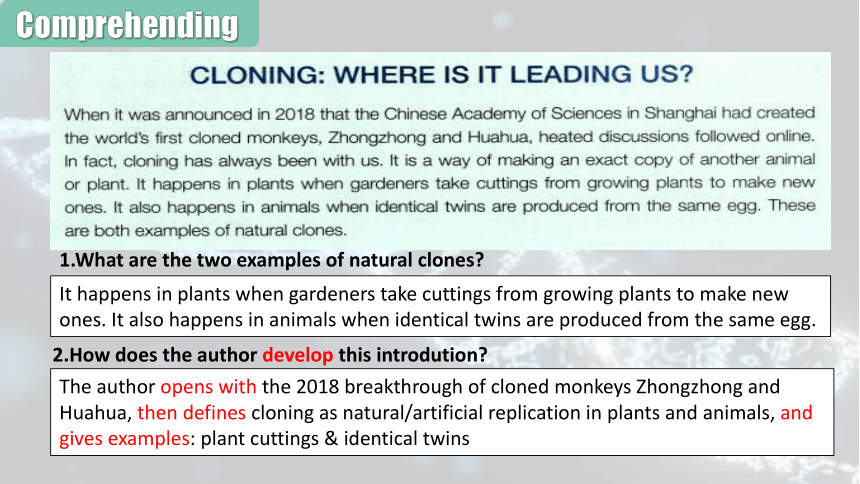
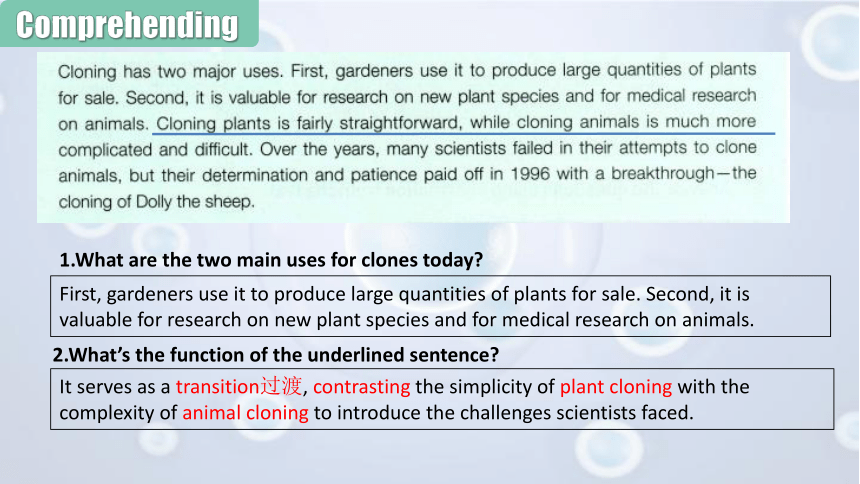
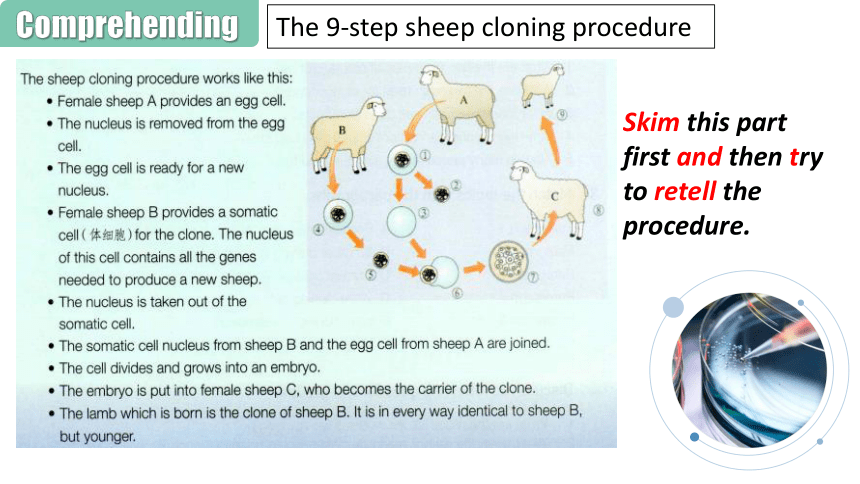
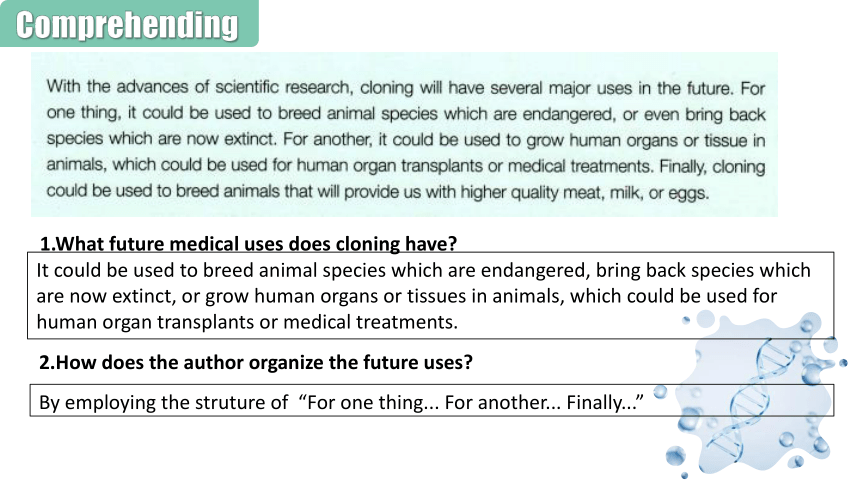
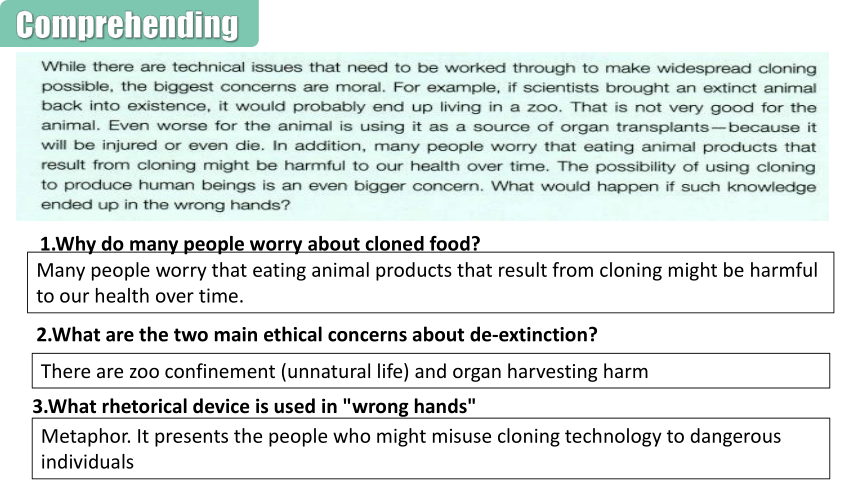
文档简介
(共20张PPT)
CLONING: WHERE IS IT LEADING US
人教版选择性必一
Unit2 Workbook Reading and Writing
Understand the basic principles and procedures of cloning technology.
Improve reading strategies for scientific texts (e.g. information scanning).
Analyze the author’s purpose and rhetorical devices (e.g., metaphor, sequential structure).
Develop critical thinking to evaluate the pros and cons of cloning technology.
Foster reflection on the ethical implications of scientific advancements.
Expand academic vocabulary (e.g., nucleus, embryo, somatic cell).
Teaching Objectives
If scientists could bring back extinct animals like dinosaurs through cloning, would you support this idea Why or why not
Lead-in
It would help us study ancient species and understand evolution better
Cloned animals might suffer in modern environments, and it could disrupt ecosystems.
It depends on whether we can guarantee their welfare and control potential risks.
01
02
03
Suggested Answers
Today’s article explores exactly these questions—let’s read to discover how cloning works, its future uses, and the big moral debates it raises.
Article Structure Analysis
Skim the passage first and then match the topic with the paragraphs.(Exercise 3 )
Para.1 D What cloning is
Para.2 C Current uses of cloning
Para.3 E How cloning a sheep works
Para.4 A Possible uses of cloning in the furure
Para.5 F Moral and ethical concerns about cloning
Para.6 B Whether lconing is good or bad
Comprehending
1.What are the two examples of natural clones
It happens in plants when gardeners take cuttings from growing plants to make new ones. It also happens in animals when identical twins are produced from the same egg.
2.How does the author develop this introdution
The author opens with the 2018 breakthrough of cloned monkeys Zhongzhong and Huahua, then defines cloning as natural/artificial replication in plants and animals, and gives examples: plant cuttings & identical twins
Comprehending
1.What are the two main uses for clones today
First, gardeners use it to produce large quantities of plants for sale. Second, it is valuable for research on new plant species and for medical research on animals.
2.What’s the function of the underlined sentence
It serves as a transition过渡, contrasting the simplicity of plant cloning with the complexity of animal cloning to introduce the challenges scientists faced.
Comprehending
1.What future medical uses does cloning have
The 9-step sheep cloning procedure
2.How does the author develop this introdution
Skim this part first and then try to retell the procedure.
Comprehending
1.What future medical uses does cloning have
It could be used to breed animal species which are endangered, bring back species which are now extinct, or grow human organs or tissues in animals, which could be used for human organ transplants or medical treatments.
2.How does the author organize the future uses
By employing the struture of “For one thing... For another... Finally...”
Comprehending
1.Why do many people worry about cloned food
Many people worry that eating animal products that result from cloning might be harmful to our health over time.
2.What are the two main ethical concerns about de-extinction
There are zoo confinement (unnatural life) and organ harvesting harm
3.What rhetorical device is used in "wrong hands"
Metaphor. It presents the people who might misuse cloning technology to dangerous individuals
Comprehending
1.What does the author mean by saying “No doubt, we will be talking about this question for a long time to come “
The author emphasizes the ongoing debate and calls readers to continue evaluating cloning’s impact as technology evolves.
2.What is author’s tone in this part
Neutral yet urgent—avoids taking sides but stresses the debate’s significance.
Suggested answer:
It may be used for harmful purposes, such as commercial exploitation of cloned organs or unethical human cloning.
Discussion
What are the moral issues involved with cloning
What does the author mean by “What would happen if such knowledge ended up in the wrong hands
Suggested answer:
One moral issue is that cloned animals may be treated as tools for science rather than living creatures. Human cloning raises concerns about rights and consciousness..
Discussion
3.What moral concerns—if any—do you have regarding cloning How important are these issues to you Why
Suggested answer:
A key concern is that human clones might be seen as replicas without individuality, leading to mistreatment. These issues are critical as they challenge our definition of humanity.
Where do you think this text might come from Identify its purpose and possible audience.
It appears to be a feature 专题article from a newspaper, meant for general audiences to introduce cloning and raise their concerns.
Inference
Cloning-Related Expressions
Accumulation
克隆基础概念 / Basic Concepts of Cloning
identical twins 同卵双胞胎
a somatic cell 体细胞
grow into an embryo 发育成胚胎
the carrier of the clone 克隆体的载体
The nucleus is removed from the egg cell. 细胞核从卵细胞中移除。
Accumulation
克隆技术流程 / Cloning Procedures
failed in their attempts to... 在尝试...时失败
determination and patience paid off with a breakthrough 决心和耐心最终带来突破
fairly straightforward 相当简单直接
Accumulation
克隆应用场景 / Applications of Cloning
breed endangered animal species 繁殖濒危动物物种
bring back extinct species 复活已灭绝物种
grow human organs or tissue in animals 在动物体内培育人类器官或组织
human organ transplants or medical treatments 人类器官移植或医疗用途
breed animals that will provide us with higher quality meat, milk, or eggs 培育能提供更优质肉、奶、蛋的动物
Accumulation
克隆争议与问题 / Controversies and Issues
technical issues that need to be worked through 需要解决的技术问题
the biggest concerns are moral 最大的担忧是道德问题
Bring an extinct animal back into existence 让已灭绝动物复活
end up living in a zoo 最终生活在动物园里
Eating animal products that result from cloning might be harmful to our health over time 长期食用克隆动物产品可能对健康有害
Accumulation
克隆的未来思考 / Future Considerations
When it comes to cloning, we wonder, ultimately, whether cloning will help or harm the world. 关于克隆,我们最终思考的是它会给世界带来帮助还是危害。
No doubt, we will be talking about this question for a long time to come. 毫无疑问,我们将在未来很长一段时间继续讨论这个问题。
社会反应与讨论 / Social Reactions
When it was announced..., heated discussions followed online. 当...被宣布时,网上引发了热烈讨论。
Writing
Imagine that you are a scientist and that you have the choice to clone or not to clone a particular animal species.Write a report about cloning an extinct animal.
"Last year our team made an amazing find of Tyrannosaurus Rex’s DNA encased in amber. In theory, this could be used to clone T. Rex, and bring this long-extinct dinosaur species back to life. However, in the end our team decided to give up this idea.
There are several reasons for this decision. First, we don’t know enough about T. Rex, so we are not able to take care of such a creature appropriately. What can it eat, for example Even though we may have some ideas of what T. Rex ate long ago, this food may no longer exist now. We also know very little about what kind of living environment a T. Rex needs. Without proper food or living environment, it is quite possible that the animal would get ill or die before we find answers to these questions. Second, the DNA is not quite complete. This raises not only the possibility of failure in cloning it, but also that even if we succeeded, it would not be all that healthy. Since we are dealing with DNA that is millions of years old, it is probable that the clone will suffer abnormalities and live only for a short time and in pain. There are just too many unknowns."
"Though we do not plan on using the DNA to make a clone, it is still quite useful for study, and there are many things we hope to learn from it. Perhaps in the future, scientists will have a better basis of knowledge with which cloning a T. Rex will become a reality. It is just not the time right now.
Whether technology is a curse or a blessing depends on how we use it.
CLONING: WHERE IS IT LEADING US
人教版选择性必一
Unit2 Workbook Reading and Writing
Understand the basic principles and procedures of cloning technology.
Improve reading strategies for scientific texts (e.g. information scanning).
Analyze the author’s purpose and rhetorical devices (e.g., metaphor, sequential structure).
Develop critical thinking to evaluate the pros and cons of cloning technology.
Foster reflection on the ethical implications of scientific advancements.
Expand academic vocabulary (e.g., nucleus, embryo, somatic cell).
Teaching Objectives
If scientists could bring back extinct animals like dinosaurs through cloning, would you support this idea Why or why not
Lead-in
It would help us study ancient species and understand evolution better
Cloned animals might suffer in modern environments, and it could disrupt ecosystems.
It depends on whether we can guarantee their welfare and control potential risks.
01
02
03
Suggested Answers
Today’s article explores exactly these questions—let’s read to discover how cloning works, its future uses, and the big moral debates it raises.
Article Structure Analysis
Skim the passage first and then match the topic with the paragraphs.(Exercise 3 )
Para.1 D What cloning is
Para.2 C Current uses of cloning
Para.3 E How cloning a sheep works
Para.4 A Possible uses of cloning in the furure
Para.5 F Moral and ethical concerns about cloning
Para.6 B Whether lconing is good or bad
Comprehending
1.What are the two examples of natural clones
It happens in plants when gardeners take cuttings from growing plants to make new ones. It also happens in animals when identical twins are produced from the same egg.
2.How does the author develop this introdution
The author opens with the 2018 breakthrough of cloned monkeys Zhongzhong and Huahua, then defines cloning as natural/artificial replication in plants and animals, and gives examples: plant cuttings & identical twins
Comprehending
1.What are the two main uses for clones today
First, gardeners use it to produce large quantities of plants for sale. Second, it is valuable for research on new plant species and for medical research on animals.
2.What’s the function of the underlined sentence
It serves as a transition过渡, contrasting the simplicity of plant cloning with the complexity of animal cloning to introduce the challenges scientists faced.
Comprehending
1.What future medical uses does cloning have
The 9-step sheep cloning procedure
2.How does the author develop this introdution
Skim this part first and then try to retell the procedure.
Comprehending
1.What future medical uses does cloning have
It could be used to breed animal species which are endangered, bring back species which are now extinct, or grow human organs or tissues in animals, which could be used for human organ transplants or medical treatments.
2.How does the author organize the future uses
By employing the struture of “For one thing... For another... Finally...”
Comprehending
1.Why do many people worry about cloned food
Many people worry that eating animal products that result from cloning might be harmful to our health over time.
2.What are the two main ethical concerns about de-extinction
There are zoo confinement (unnatural life) and organ harvesting harm
3.What rhetorical device is used in "wrong hands"
Metaphor. It presents the people who might misuse cloning technology to dangerous individuals
Comprehending
1.What does the author mean by saying “No doubt, we will be talking about this question for a long time to come “
The author emphasizes the ongoing debate and calls readers to continue evaluating cloning’s impact as technology evolves.
2.What is author’s tone in this part
Neutral yet urgent—avoids taking sides but stresses the debate’s significance.
Suggested answer:
It may be used for harmful purposes, such as commercial exploitation of cloned organs or unethical human cloning.
Discussion
What are the moral issues involved with cloning
What does the author mean by “What would happen if such knowledge ended up in the wrong hands
Suggested answer:
One moral issue is that cloned animals may be treated as tools for science rather than living creatures. Human cloning raises concerns about rights and consciousness..
Discussion
3.What moral concerns—if any—do you have regarding cloning How important are these issues to you Why
Suggested answer:
A key concern is that human clones might be seen as replicas without individuality, leading to mistreatment. These issues are critical as they challenge our definition of humanity.
Where do you think this text might come from Identify its purpose and possible audience.
It appears to be a feature 专题article from a newspaper, meant for general audiences to introduce cloning and raise their concerns.
Inference
Cloning-Related Expressions
Accumulation
克隆基础概念 / Basic Concepts of Cloning
identical twins 同卵双胞胎
a somatic cell 体细胞
grow into an embryo 发育成胚胎
the carrier of the clone 克隆体的载体
The nucleus is removed from the egg cell. 细胞核从卵细胞中移除。
Accumulation
克隆技术流程 / Cloning Procedures
failed in their attempts to... 在尝试...时失败
determination and patience paid off with a breakthrough 决心和耐心最终带来突破
fairly straightforward 相当简单直接
Accumulation
克隆应用场景 / Applications of Cloning
breed endangered animal species 繁殖濒危动物物种
bring back extinct species 复活已灭绝物种
grow human organs or tissue in animals 在动物体内培育人类器官或组织
human organ transplants or medical treatments 人类器官移植或医疗用途
breed animals that will provide us with higher quality meat, milk, or eggs 培育能提供更优质肉、奶、蛋的动物
Accumulation
克隆争议与问题 / Controversies and Issues
technical issues that need to be worked through 需要解决的技术问题
the biggest concerns are moral 最大的担忧是道德问题
Bring an extinct animal back into existence 让已灭绝动物复活
end up living in a zoo 最终生活在动物园里
Eating animal products that result from cloning might be harmful to our health over time 长期食用克隆动物产品可能对健康有害
Accumulation
克隆的未来思考 / Future Considerations
When it comes to cloning, we wonder, ultimately, whether cloning will help or harm the world. 关于克隆,我们最终思考的是它会给世界带来帮助还是危害。
No doubt, we will be talking about this question for a long time to come. 毫无疑问,我们将在未来很长一段时间继续讨论这个问题。
社会反应与讨论 / Social Reactions
When it was announced..., heated discussions followed online. 当...被宣布时,网上引发了热烈讨论。
Writing
Imagine that you are a scientist and that you have the choice to clone or not to clone a particular animal species.Write a report about cloning an extinct animal.
"Last year our team made an amazing find of Tyrannosaurus Rex’s DNA encased in amber. In theory, this could be used to clone T. Rex, and bring this long-extinct dinosaur species back to life. However, in the end our team decided to give up this idea.
There are several reasons for this decision. First, we don’t know enough about T. Rex, so we are not able to take care of such a creature appropriately. What can it eat, for example Even though we may have some ideas of what T. Rex ate long ago, this food may no longer exist now. We also know very little about what kind of living environment a T. Rex needs. Without proper food or living environment, it is quite possible that the animal would get ill or die before we find answers to these questions. Second, the DNA is not quite complete. This raises not only the possibility of failure in cloning it, but also that even if we succeeded, it would not be all that healthy. Since we are dealing with DNA that is millions of years old, it is probable that the clone will suffer abnormalities and live only for a short time and in pain. There are just too many unknowns."
"Though we do not plan on using the DNA to make a clone, it is still quite useful for study, and there are many things we hope to learn from it. Perhaps in the future, scientists will have a better basis of knowledge with which cloning a T. Rex will become a reality. It is just not the time right now.
Whether technology is a curse or a blessing depends on how we use it.
